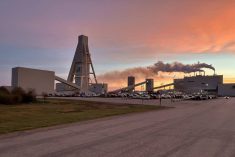OSLO, Norway (Reuters) — Scientists have found a way to forecast El Nino weather events in the Pacific Ocean a year in advance, which is long enough to let farmers plant crops less vulnerable to global shifts in rainfall.
While far from flawless, the technique doubles current six-month predictions of El Nino.
“Better forecasting will mean farmers can adapt,” said Hans Joachim Schellnhuber, head of the Potsdam Institute for Climate Impact Research and co-author of a report with experts in Russia, Israel, Germany and the United States.
Read Also

B.C. ostriches culled, CFIA confirms
Ostriches on an embattled Edgewood, B.C. farm have been culled after a prolonged legal battle, the Canadian Food Inspection Agency has confirmed.
El Ninos are a warming of the eastern Pacific Ocean linked in the past to floods in Peru and Ecuador, droughts in Australia and Indonesia and maybe severe winters in Europe.
They typically happen every two to seven years, but scientists have been unable to find the causes of patterns that have occurred naturally throughout history and are among the most disruptive of extreme weather events.
The new system, built on a network of temperature records around the Pacific Ocean since 1950, correctly spotted El Nino events a year in advance more than half the time and gave false alarms fewer than one year in 10.
“We can develop an efficient 12-month forecasting scheme, i.e. achieve some doubling of the early warning period,” the scientists wrote in the U.S. journal Proceedings of the National Academy of Sciences.
Even though the new computer system is not always right, farmers might find it worthwhile to invest in drought- or flood-resistant varieties of crops when there was a risk of an El Nino in a year’s time.
“Six months’ warning is too short. If you are a farmer in India, or in Zimbabwe or Brazil, you have bought your seeds or even planted them. If you have a 12- or even 18-month early warning, you have a full agricultural cycle,” Schellnhuber said.
Predictions of El Nino, part of a larger natural pattern known as the El Nino Southern Oscillation, have often been unreliable.
In September 2012, for example, the World Meteorological Organization saw a “moderately high likelihood” of an El Nino in the months ahead that did not materialize. In late June it said there were now “neutral” conditions in the Pacific.
A separate report, looking at evidence for El Nino events in the growth rings of more than 2,000 trees stretching back 700 years, suggested that climate change was the cause of a rise in the number of El Nino events in the late 20th century.
Writing in the journal Nature Climate Change, the researchers also found that volcanic eruptions, which spew out particles that can affect sunlight, apparently affect El Nino cycles.
They argued that was evidence that heat-trapping gases from burning fossil fuels could similarly affect the cycle.
More strong El Ninos are expected this century because of rising concentrations of greenhouse gases, said lead author Jinbao Li of the University of Hong Kong.














